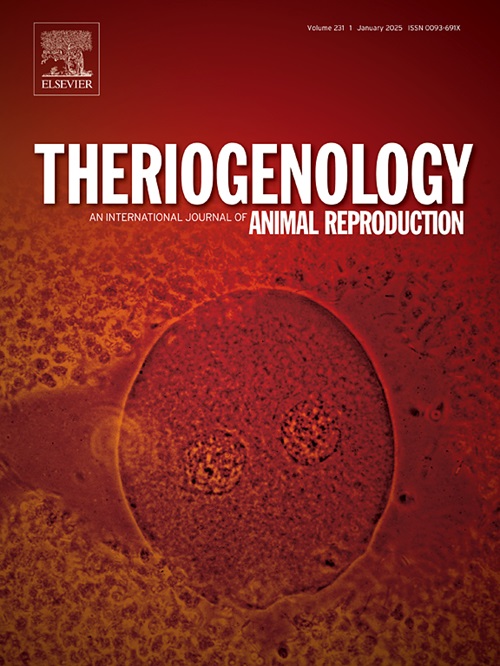Single-dose recombinant FSH as a viable alternative to multi-dose porcine FSH in commercial superovulation protocols in cows
IF 2.4
2区 农林科学
Q3 REPRODUCTIVE BIOLOGY
引用次数: 0
Abstract
Superovulation (SOV) for embryo transfer (ET) typically requires eight decreasing doses of porcine FSH (pFSH) due to the short half-life. Recently, a recombinant FSH (rFSH) formulation has become available, allowing for SOV with a single treatment. This study aimed to compare the outcomes of SOV in commercial ET programs using eight doses of pFSH versus a single administration of rFSH. Data from 569 SOV procedures conducted under commercial conditions with pFSH (n = 291) or rFSH (n = 278) were evaluated. No significant differences were observed regarding the total number of recovered structures (TS), degenerated embryos (DG), and transferable embryos (TE). However, the number and proportion of unfertilized oocytes (UF) relative to TS were higher in the rFSH group. Conversely, the proportion of DG relative to TS was higher in the pFSH group. The proportion of TE relative to TS was consistent at 60 % for both treatments. Finally, when a small subset of cows (n = 12) were SOV four times with rFSH at 40- to 60-day intervals, no significant differences were observed in TS or TE. In conclusion, a single administration of rFSH provides SOV outcomes comparable to those achieved with eight administrations of pFSH in commercial ET programs and results seem constant across repeated treatments with rFSH.
单剂量重组卵泡刺激素作为奶牛超排卵商业方案中多剂量猪卵泡刺激素的可行替代品
胚胎移植(ET)的超排卵(SOV)通常需要8个减少剂量的猪卵泡刺激素(pFSH),因为半衰期短。最近,一种重组FSH (rFSH)配方已经可用,允许单次处理SOV。本研究旨在比较商业ET项目中使用8剂pFSH和单剂rFSH的SOV结果。在商业条件下使用pFSH (n = 291)或rFSH (n = 278)进行的569例SOV手术的数据进行了评估。在恢复结构(TS)、退化胚胎(DG)和可移植胚胎(TE)的总数方面,未观察到显著差异。然而,与TS相比,rFSH组未受精卵母细胞(UF)的数量和比例更高。相反,在pFSH组中DG相对于TS的比例更高。两种治疗中TE相对于TS的比例一致为60%。最后,当一小部分奶牛(n = 12)在40至60天的间隔内使用rFSH进行四次SOV时,没有观察到TS或TE的显着差异。综上所述,单次施用rFSH所提供的SOV结果与商业ET项目中八次施用pFSH所获得的结果相当,并且在重复使用rFSH治疗的结果似乎是一致的。
本文章由计算机程序翻译,如有差异,请以英文原文为准。
求助全文
约1分钟内获得全文
求助全文
来源期刊

Theriogenology
农林科学-生殖生物学
CiteScore
5.50
自引率
14.30%
发文量
387
审稿时长
72 days
期刊介绍:
Theriogenology provides an international forum for researchers, clinicians, and industry professionals in animal reproductive biology. This acclaimed journal publishes articles on a wide range of topics in reproductive and developmental biology, of domestic mammal, avian, and aquatic species as well as wild species which are the object of veterinary care in research or conservation programs.
 求助内容:
求助内容: 应助结果提醒方式:
应助结果提醒方式:


